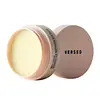What's inside
What's inside
 Key Ingredients
Key Ingredients

 Benefits
Benefits

 Concerns
Concerns

 Ingredients Side-by-side
Ingredients Side-by-side

Caprylic/Capric Triglyceride
MaskingWater
Skin ConditioningGlyceryl Behenate
EmollientEthyl Arganate
Argania Spinosa Kernel Oil
EmollientC10-18 Triglycerides
EmollientGlycerin
HumectantPropanediol
SolventPolyglyceryl-6 Polyhydroxystearate
EmulsifyingPolyglyceryl-6 Polyricinoleate
EmulsifyingMagnesium Sulfate
Butyrospermum Parkii Butter
Skin ConditioningGlyceryl Glucoside
HumectantHydrolyzed Sodium Hyaluronate
Skin ConditioningPhytosterols
Skin ConditioningPhospholipids
Skin ConditioningAloe Barbadensis Leaf Juice
Skin ConditioningPolyglycerin-6
HumectantLinoleic Acid
CleansingCitric Acid
BufferingTrisodium Ethylenediamine Disuccinate
Hydroxyacetophenone
Antioxidant1,2-Hexanediol
Skin ConditioningCaprylyl Glycol
EmollientCaprylic/Capric Triglyceride, Water, Glyceryl Behenate, Ethyl Arganate, Argania Spinosa Kernel Oil, C10-18 Triglycerides, Glycerin, Propanediol, Polyglyceryl-6 Polyhydroxystearate, Polyglyceryl-6 Polyricinoleate, Magnesium Sulfate, Butyrospermum Parkii Butter, Glyceryl Glucoside, Hydrolyzed Sodium Hyaluronate, Phytosterols, Phospholipids, Aloe Barbadensis Leaf Juice, Polyglycerin-6, Linoleic Acid, Citric Acid, Trisodium Ethylenediamine Disuccinate, Hydroxyacetophenone, 1,2-Hexanediol, Caprylyl Glycol
Butyrospermum Parkii Butter
Skin ConditioningHelianthus Annuus Hybrid Oil
EmollientTricaprylin
MaskingC10-18 Triglycerides
EmollientHydroxystearic/Linolenic/Oleic Polyglycerides
EmollientPolyhydroxystearic Acid
EmulsifyingStearyl Behenate
EmollientHelianthus Annuus Seed Wax
Skin ConditioningWater
Skin ConditioningJojoba Esters
EmollientTocopheryl Acetate
AntioxidantRibes Nigrum Seed Oil
EmollientHydroxypinacolone Retinoate
Skin ConditioningTocopherol
AntioxidantLentinus Edodes Extract
Skin ConditioningGlycerin
HumectantAcacia Decurrens Flower Wax
EmollientPolyglycerin-3
HumectantSilica Silylate
EmollientDimethyl Isosorbide
SolventSodium Citrate
BufferingPhytic Acid
Potassium Sorbate
PreservativeSodium Benzoate
MaskingButyrospermum Parkii Butter, Helianthus Annuus Hybrid Oil, Tricaprylin, C10-18 Triglycerides, Hydroxystearic/Linolenic/Oleic Polyglycerides, Polyhydroxystearic Acid, Stearyl Behenate, Helianthus Annuus Seed Wax, Water, Jojoba Esters, Tocopheryl Acetate, Ribes Nigrum Seed Oil, Hydroxypinacolone Retinoate, Tocopherol, Lentinus Edodes Extract, Glycerin, Acacia Decurrens Flower Wax, Polyglycerin-3, Silica Silylate, Dimethyl Isosorbide, Sodium Citrate, Phytic Acid, Potassium Sorbate, Sodium Benzoate
 Reviews
Reviews

Alternatives
Ingredients Explained
These ingredients are found in both products.
Ingredients higher up in an ingredient list are typically present in a larger amount.
This ingredient is also known as shea butter. It is an effective skin hydrator and emollient.
Emollients help soothe and soften your skin. It does this by creating a protective film on your skin. This barrier helps trap moisture and keeps your skin hydrated. Emollients may be effective at treating dry or itchy skin.
Shea butter is rich in antioxidants. Antioxidants help fight free-radicals, or molecules that may harm the body. It is also full of fatty acids including stearic acid and linoleic acid. These acids help replenish the skin and keep skin moisturized.
While Shea Butter has an SPF rating of about 3-4, it is not a sunscreen replacement.
Shea butter may not be fungal acne safe. We recommend speaking with a professional if you have any concerns.
Learn more about Butyrospermum Parkii ButterC10-18 Triglycerides is a skin conditioning and texture-enhancer.
It is created from glycerin and a mixture of C10-18 fatty acids.
This ingredient improves spreadability and helps thicken a product.
According to manufacturers, it usually comes from vegetable-based saturated fatty acids. Common bases for this ingredient are coconut oil, palm kernel oil, or both.
Due to the melting point being close to skin temperature, it is usually used in lip products.
Triglycerides are a main component of fat in the human body.
Learn more about C10-18 TriglyceridesGlycerin is already naturally found in your skin. It helps moisturize and protect your skin.
A study from 2016 found glycerin to be more effective as a humectant than AHAs and hyaluronic acid.
As a humectant, it helps the skin stay hydrated by pulling moisture to your skin. The low molecular weight of glycerin allows it to pull moisture into the deeper layers of your skin.
Hydrated skin improves your skin barrier; Your skin barrier helps protect against irritants and bacteria.
Glycerin has also been found to have antimicrobial and antiviral properties. Due to these properties, glycerin is often used in wound and burn treatments.
In cosmetics, glycerin is usually derived from plants such as soybean or palm. However, it can also be sourced from animals, such as tallow or animal fat.
This ingredient is organic, colorless, odorless, and non-toxic.
Glycerin is the name for this ingredient in American English. British English uses Glycerol/Glycerine.
Learn more about GlycerinWater. It's the most common cosmetic ingredient of all. You'll usually see it at the top of ingredient lists, meaning that it makes up the largest part of the product.
So why is it so popular? Water most often acts as a solvent - this means that it helps dissolve other ingredients into the formulation.
You'll also recognize water as that liquid we all need to stay alive. If you see this, drink a glass of water. Stay hydrated!
Learn more about Water